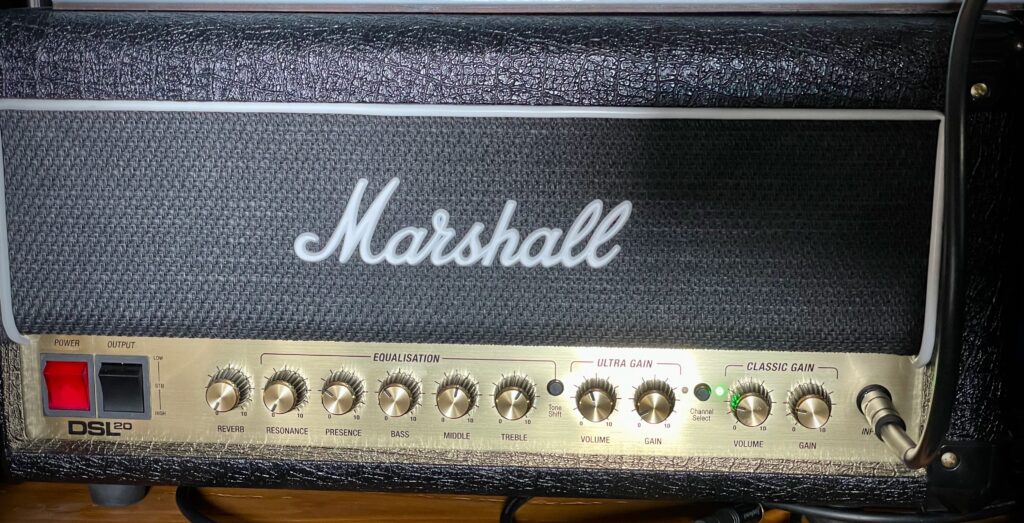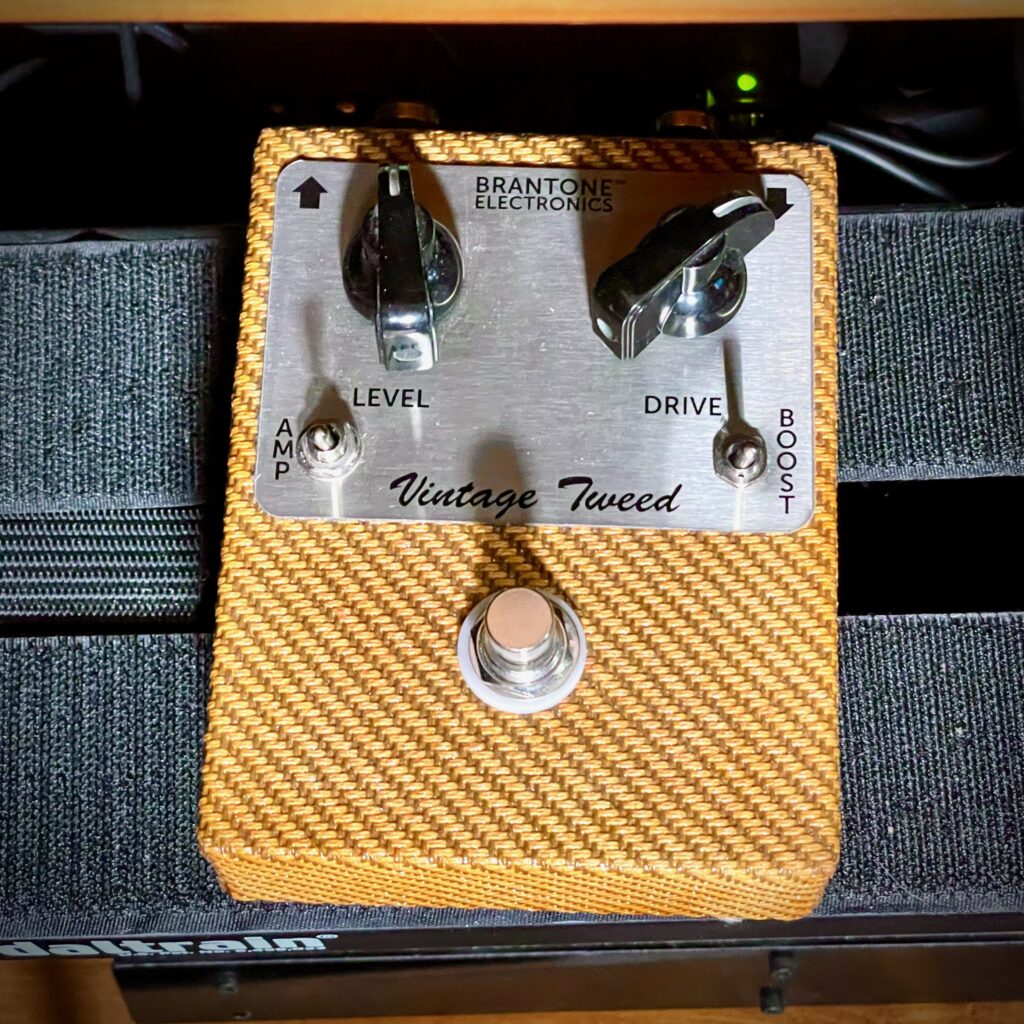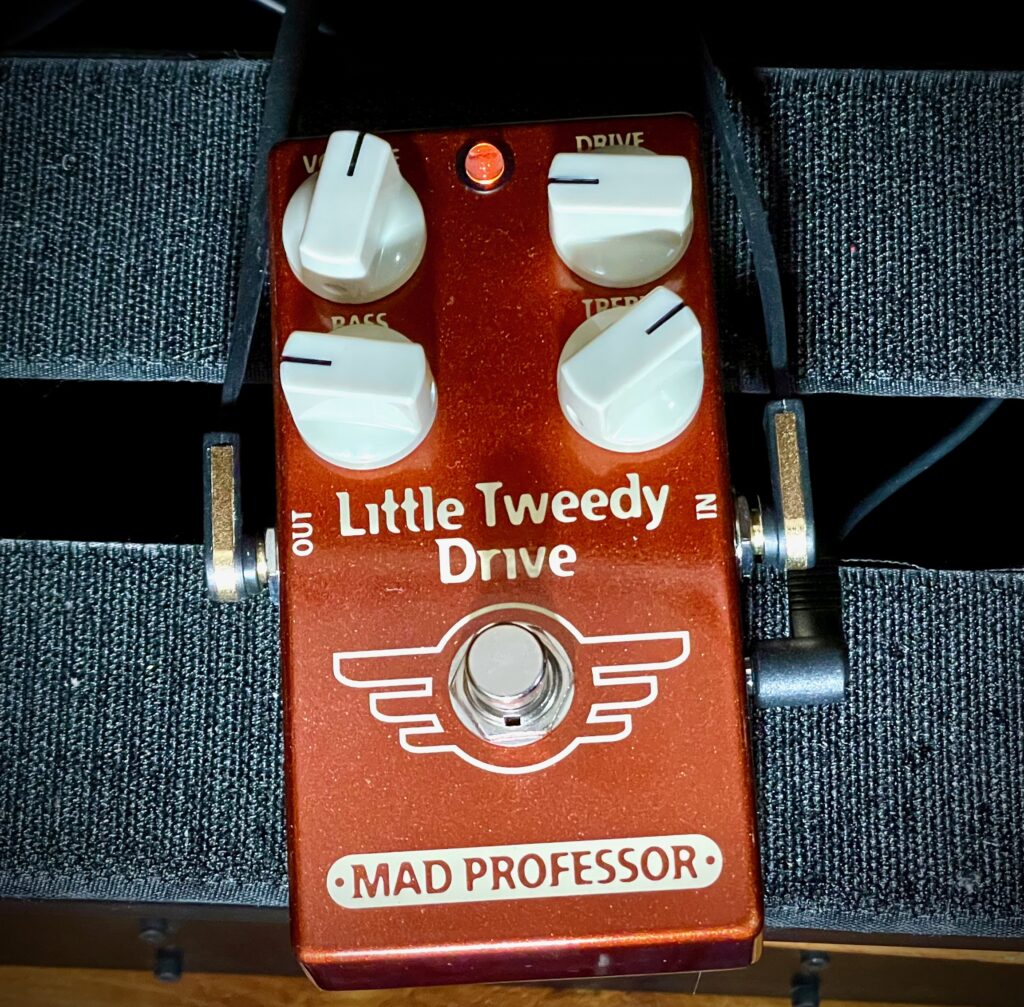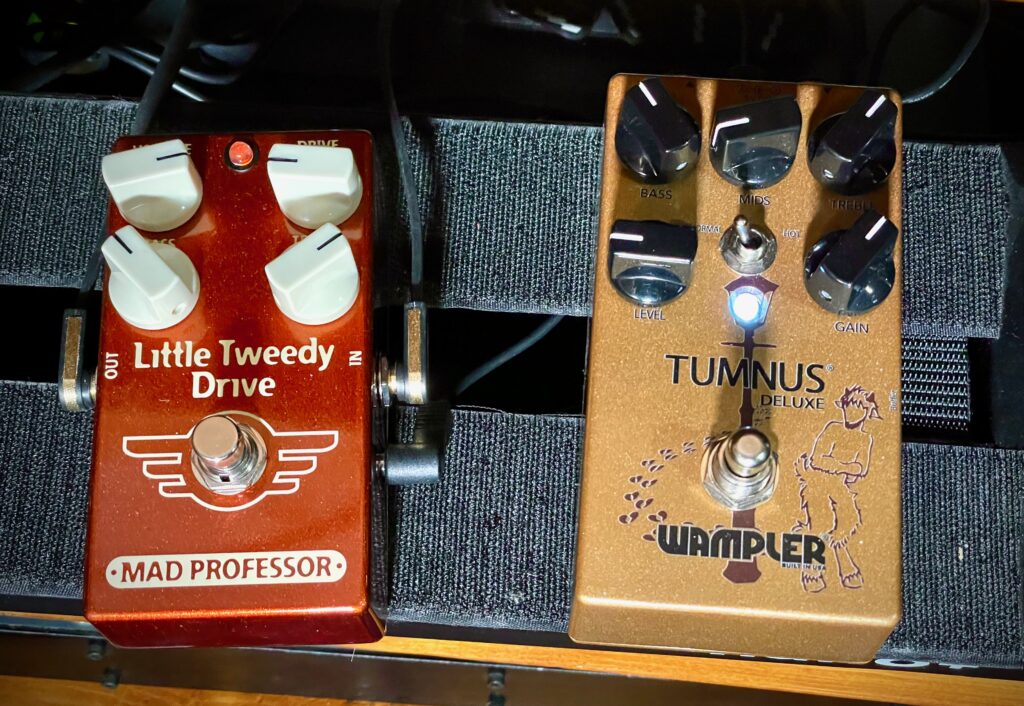Over on Twitter, my friend Alessandro asked for opinions about Mad Professor’s Little Tweedy Drive.
Yes, I have opinions about this particular pedal. I wasn’t a fan when I first got this pedal. Will that change, when I take a second look at the Little Tweedy Drive? Read on to find out.
Table of Contents
- What Is The Little Tweedy Drive?
- Where Did You Get Your Little Tweedy Drive From?
- How Tweedy Is The Little Tweed Drive? Let’s Find Out
- What Is Your Signal Chain?
- The ‘Control’ Tone: The Brantone Electronics Vintage Tweed Overdrive
- The Contender: The Mad Professor Little Tweedy Drive On Its Own
- Getting A Great Tone Out Of The Little Tweedy Drive
- The Holy Grail: The Tweed Deluxe Amp
- Final Results
What Is The Little Tweedy Drive?
The Little Tweedy Drive is an overdrive pedal from Mad Professor. (Disclaimer: Mad Professor are my favourite pedal manufacturer. I’m definitely biased!) According to their own marketing, it’s chasing the tone of classic tweed amps like the Tweed Deluxe. Mad Professor themselves say that it’s “big”, “fat”, with a “punchy midrange”, has a “sweet growl” and “a tone that almost purrs.”
They’re describing my ideal tone.
My favourite pedal is my beloved Mad Professor Sweet Honey Overdrive (SHOD for short), which I believe is the world’s best-selling tweed-tone pedal. Despite being a tweed-tone pedal, it isn’t modelled on the 5e3 Tweed Deluxe. When I want that sound, I grab the amazing Brantone Electronics Vintage Tweed Overdrive.
If the Little Tweedy Drive can get even closer to the Tweed Deluxe amp, there’s no-one who would be happier.
And these video demos (from when the pedal was first released) are certainly promising:
The second video demo can be found here: https://www.facebook.com/MadProfessorAmplification/videos/mad-professor-little-tweedy-drive/10159852727195290/. Sorry, Facebook doesn’t play nice with sharing with other sites, so I can’t embed the video directly 🙁
Where Did You Get Your Little Tweedy Drive From?
I bought mine second-hand from eBay, back in July 2019. It’s the only example that I’ve ever played. That will become important later on, when (spoiler alert!) we discuss the problem with this pedal.
This pedal was discontinued at some point during the pandemic. I’m not exactly sure when; reportedly by mid-May 2021. I’ve not found anything from Mad Professor themselves to explain why this pedal was discontinued.
After reading this blog post, if you want one yourself, you might be able to find a new-old stock example gathering dust in a store somewhere. They also turn up on the second-hand market from time to time.
How Tweedy Is The Little Tweed Drive? Let’s Find Out
Mad Professor clearly marketed this pedal as a Tweed Deluxe-in-a-box pedal. But does it deliver?
I just happen to have a modern-day re-issue Tweed Deluxe amp from Fender right here. I’ve also got a rare Brantone Electronics Vintage Tweed Overdrive, which is the closest I’ve ever come to a 5e3 sound in a box.
So give me a moment to get everything wired up, and I’ll let you hear for yourself whether or not this particular example of a Little Tweedy Drive delivers.
What Is Your Signal Chain?
The Pedal Rig
I’m comparing three different pedal setups:
- My ‘control’ tone is the Brantone Electronics Vintage Tweed Overdrive. This is the sound that I’m trying to match or (subjectively) better.
- Then I’ve got the Mad Professor Little Tweedy Drive on its own. This is the main comparison: does my LTD deliver that 5e3 sound in a box?
- And finally, I’m running the Wampler Tumnus Deluxe into the Little Tweedy Drive. You’ll see why later on.
All of the pedals are in this rig:
- My PRS McCarty 594,
- into the drive pedals,
- into a pair of Neunaber Slate pedals, for digital tape delay and digital spring reverb,
- into my Marshall DSL20HR head,
- into my Two Notes Captor for -20db attenuation,
- out to a pair of Victory open-backed 1×12 cabs, fitted with a 16 ohm Celestion Blue and a 16 ohm Celestion A-Type speaker
Each pedal is in its own loop in my Gigrig G2, so that I can completely remove the pedal from the signal chain when I’m not using it. That’s very important with Klon klones, which often contain always-on buffers that colour the signal even when the pedal is switched off.
I’ve chosen the Tumnus Deluxe because it has extra EQ controls that I’m going to need.
I’m using the Marshall because it’s a fantastic pedal platform amp. It features six different EQ controls (Treble, Middle, Bass, plus Presence, Resonance, and Gain – which affects the low-mids that are so important to tweed tone), which allows me to tune the amp to any pedal that I want to use.
Here’s a photo of the settings of my Marshall. I used the same amp settings for all three pedal recordings:

The two Celestion speakers are the ones I use here at home all the time.
- The A-Type was released in 2014. It’s basically Celestion’s answer to the Jenson speakers traditionally used in vintage Fender amps.
- The Blue is a legendary speaker. It’s a popular choice for folks who don’t like the Jenson speakers in their 5e3 Tweed Deluxe amps.
Both speakers are mic’d up using small diaphragm condenser mics. These mics are very flat, very unflattering. They do a good job of capturing how the pedals sound in the room.
There’s no post-processing at all.
The Real Amp Rig
For the Tweed Deluxe amp, I’m using:
- Fender 57 Custom Deluxe re-issue from 2021,
- into my Fryette PS-100 Power Station for attenuation,
- into a rack-mounted FX processor for noise gating, EQ, digital tape delay and digital spring reverb
- out to my SYN-5050 power amp,
- into the same pair of Victory 1×12 cabs
I’m just using input 1 on the the bright channel on the Tweed Deluxe, with the two channel controls at the classic 4 (bright channel) and 8 (normal channel) setting. It’s one of my favourite 5e3 tones.
I’m using the PS-100 to attenuate the Tweed Deluxe. This way I don’t annoy the neighbours, and I keep my hearing for another day. (This amp is LOUD in the room. I have no idea how YouTubers like Rhett Shull sit right next to theirs when they play it.)
I’m not using the power amp that’s built into the PS-100. It’s on the blink right now. That’ll be a story for another blog. Instead, I’ve taken the line out of the PS-100, and ran it (via some effects) into a different power amp.
In my rack-mounted FX processor:
- I’ve got a basic expander gate, because real amps are noisy.
- I’m running an EQ curve to tame the low-end and bring out some of the top-end. Without it, my Tweed Deluxe sounds dark and muddy.
- I’m also running some digital tape delay and digital spring reverb there. The delay and reverb do sound different to my Neunaber pedals. I’ll cover that in a future blog post.
Even though you’ll be hearing the amp through the same set of mic’d up speakers, it’s not going to be an apples-to-apples comparison. That’s why I’m not using the amp itself as the ‘control’ sound.
The ‘Control’ Tone: The Brantone Electronics Vintage Tweed Overdrive
Man, the more time I spend with this pedal, the more I love it. While it doesn’t recreate the feel or saturation of my real Tweed Deluxe, the overall tone is close enough – and it’s often more convenient than wiring up my real tweed amp for casual playing.
Through my rig, this is the kind of tone that any tweed-deluxe-in-a-box should be aiming for:
It’s got everything that I want out of a great 5e3 Tweed Deluxe tone: foundational lower-mids, a rounded attack (compared to a Marshall), and a controlled raspiness. The mids are nice and forward, without being in-your-face forward. The only thing missing is a bit more saturation.
For reference, here’s a photo showing the settings that I used to capture this tone:

The Contender: The Mad Professor Little Tweedy Drive On Its Own
Next up, here’s what the Little Tweedy Drive sounds like on its own, through my rig:
And, for reference, here’s a photo showing the settings that I used:

Sadly, it doesn’t deliver on the promise of those video demos I shared earlier in this blog post.
While there’s a lot to like about the sound of the Little Tweedy Drive, it’s totally ruined by the distortion that you can hear. To my ears, the circuit has gone way overboard while chasing that raspiness, and has just ended up overloading part of the circuit with a signal that’s just too hot for it to handle.
In case you’re not familiar, my PRS McCarty 594 features under-wound vintage-voiced humbuckers. They are not hot pickups in any way, shape or form. It’s reasonable to expect the LTD to cope with them just fine.
At this point, I must remind you that this is what my second-hand Little Tweedy Drive sounds like through my rig. It’s the only Little Tweedy Drive pedal that I’ve ever had. I’ve no idea if they all sound like this, or whether I just got unlucky with the one that I picked up.
That got me thinking. Where is the distortion coming from? Is there a way to work around it? I disappeared down that particular rabbit hole for a good month or so, trying to come up with an answer.
I think I did.
Getting A Great Tone Out Of The Little Tweedy Drive
Before I explain how I got it, take a listen to the final tone that I settled on:
That’s much more usable, right? The distortion has been tamed to produce the raspy tone of the Vintage Tweed Overdrive pedal. It’s now a bit more mid-forward too, which is a good thing. And I think it shows that you can get close to the 5e3 sound using the Little Tweedy Drive.
How did I do it?
After a lot of trial and error, I came to the conclusion that the distortion seems to be some sort of circuit overload caused by the input signal. If I turn the input signal down, there’s a lot less of that unwanted distortion. If I also reduce the amount of bass going into the Little Tweedy Drive, the unwanted distortion cleans up a bit more.
So … if I can’t use the Little Tweedy Drive on its own, can I use it as a tone machine? What if I put another pedal in front to drastically cut the input signal, shape the tone, and do most of the overdrive … and then run the LTD with the volume cranked?
That’s how I ended up with that sound, using the setup shown here:

With the input signal turned way down, the Little Tweedy Drive on its own doesn’t overdrive any more. I needed to use a pedal in front of it to provide the overdrive.
There’s so many drive pedals that could be used for this role. I went with the Tumnus Deluxe because it’s got that fantastic 3-band EQ, and it’s one of the smoother-sounding drive pedals around. I figured that anything too aggressive wouldn’t sound all that tweedy after the LTD had coloured the sound.
The Holy Grail: The Tweed Deluxe Amp
To finish off, let’s hear what my Tweed Deluxe amp sounds like:
A reminder: the pedals went through a different signal chain to the amp. For the amp, there’s a different attenuator (which sounds different), added EQ, and a different unit providing the delay & reverb.
The main take away for me is that the real amp is much more saturated than the pedals. There’s also more compression going on, which made the real amp sound a lot louder at similar volume levels.
I’ve still got a ways to go before I’m getting the best out of this amp here at home. I still think it sounds great, though.
Final Results
In private, I’ve often referred to the Little Tweedy Drive as one of the worst pedals I’ve ever had. The distortion you can clearly hear in that clip … I think it makes the pedal totally unusable.
The alternative setup that I came up with … I like that sound a lot.
Is it a good sound for playing live or recording? That I don’t know, because I don’t do either right now. I’ll leave that for you to tell me in the comments below.
